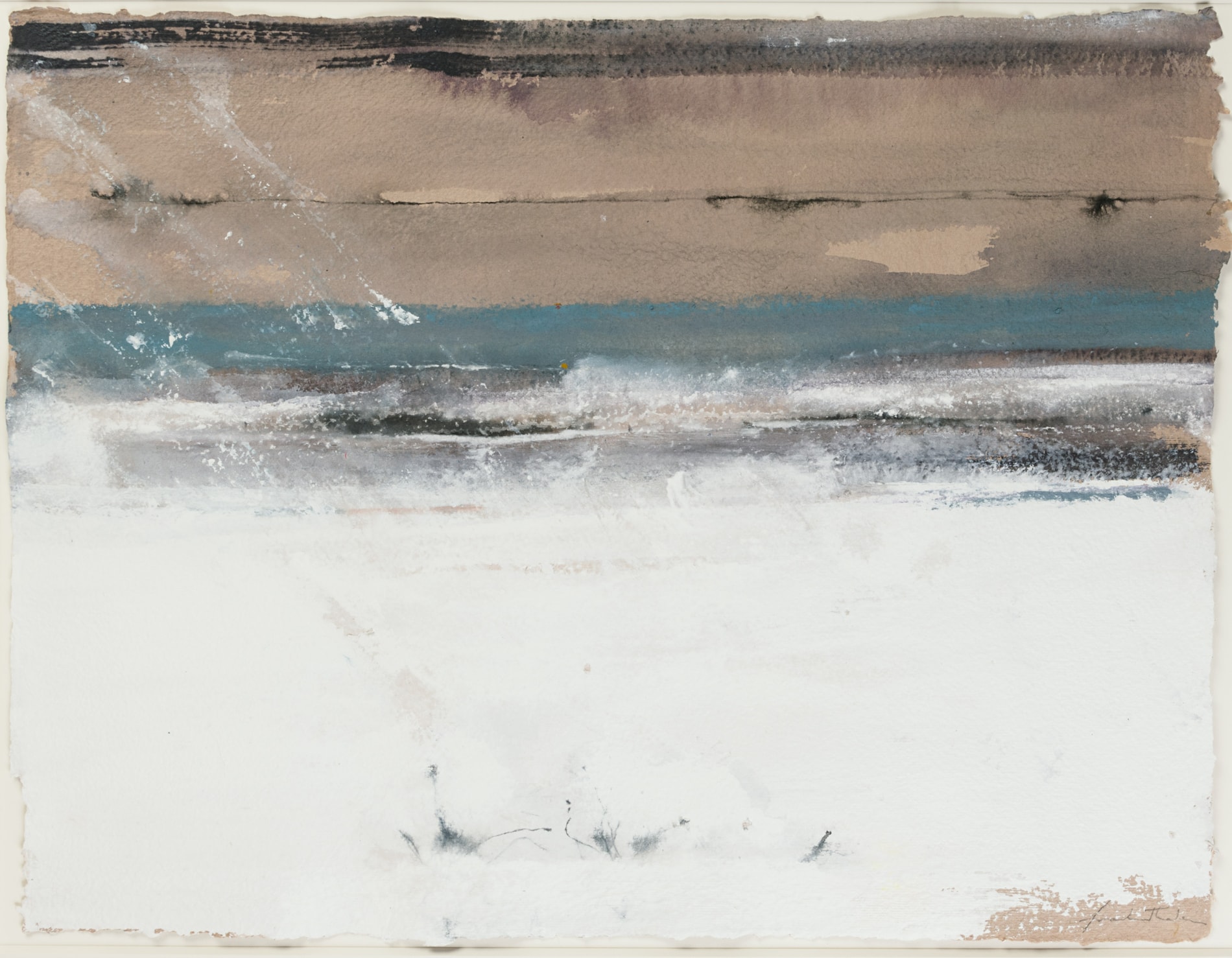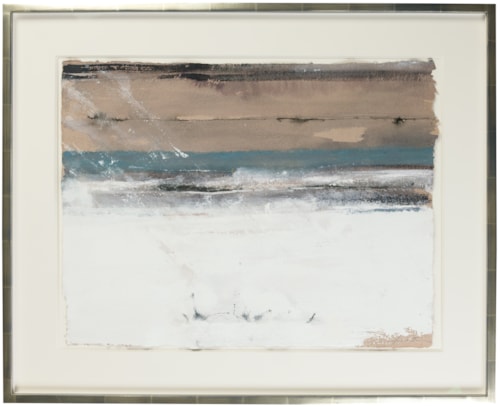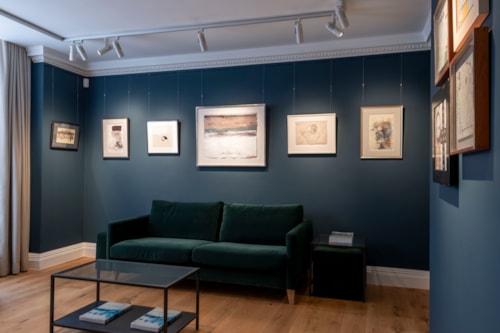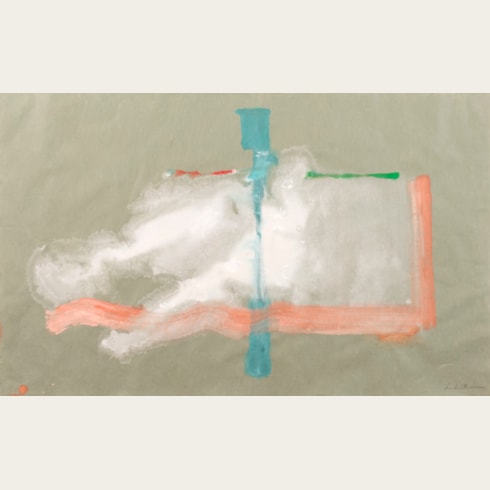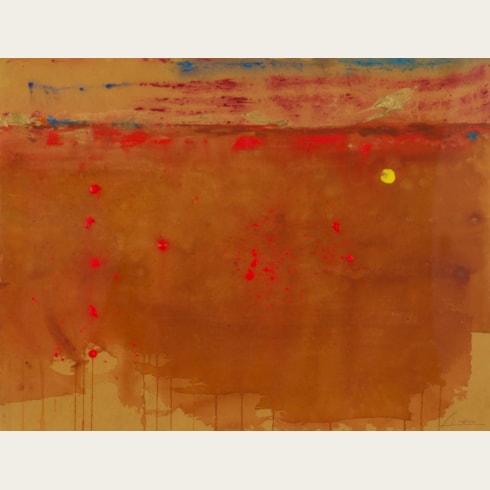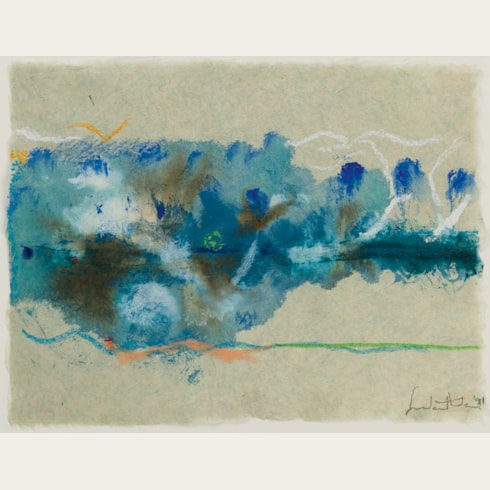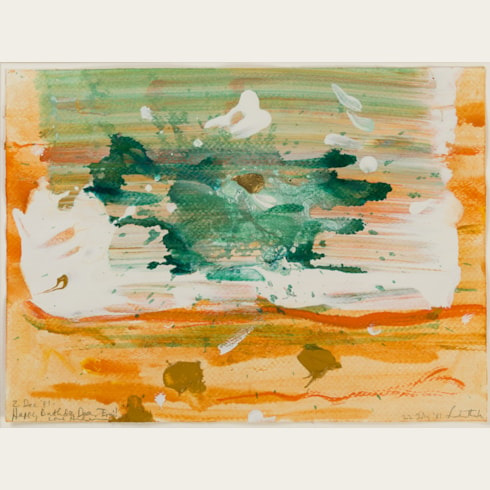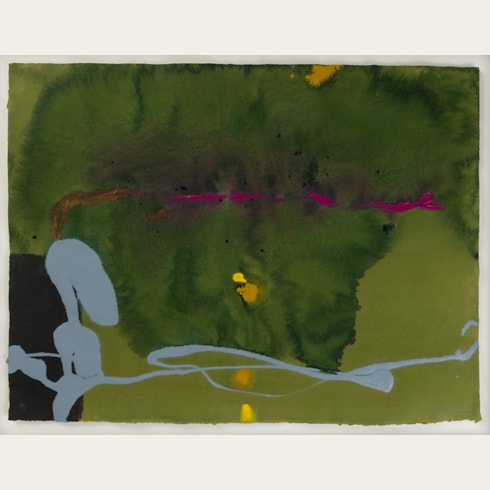Helen FRANKENTHALER
(New York 1928 - Darien 2011)
Untitled (P94-5), 1994
Acrylic on light brown paper.
Signed Frankenthaler in pencil at the lower right.
514 x 658 mm. (20 1/4 x 25 7/8 in.)
Signed Frankenthaler in pencil at the lower right.
514 x 658 mm. (20 1/4 x 25 7/8 in.)
Works on paper were an important part of Helen Frankenthaler’s oeuvre throughout her career, and their significance grew in particular from the late 1970s onwards. As the artist has noted, ‘Working on paper can even replace working on canvas for me, for periods of time…more and more, paper is painting.’
This large sheet was drawn in 1994, during a period of a decade - between 1992 and 2002 - when Frankenthaler produced very few paintings and worked almost exclusively on paper. Speaking on the occasion of an exhibition of her works on paper from the decade of the 1990s, the artist said that ‘I get lost, whatever medium I’m working in – painting, sculpture, works on paper, graphics…for the time I am totally into creating a work. I am obsessed and the energy flows, the adrenalin flows, the ideas flow. I can’t work fast enough and that’s great. As I said before, to push is hell…I know when I started all these works on paper not too long ago, the first few felt slow and unresolved and then suddenly something clicked and I couldn’t get them out fast enough and I wanted more and more paper. Every so often I’d tear one up and my studio assistant would tremble but that’s the way it goes.’
In 1974 Frankenthaler began renting a summer house at Shippan Point in Stamford, Connecticut, facing the waters of Long Island Sound, and in 1978 she bought a home there, establishing a second studio. As has been pointed out, ‘the long, horizontal divisions and subtle tonalities of her paintings of the 1980s and 1990s can be read as subliminal reactions to the changing light and the seasonal variations of sky, sea, and beach, seen from her seaside Connecticut home.’ Indeed, the horizontal format common to much of Frankenthaler’s work, especially those on paper, has often been seen as indicative of a response to nature. However, as the artist pointed out in a 1997 interview, ‘Landscape is a loaded question for an abstract painter. When one looks at an abstract horizontal canvas, one more or less consciously perceives nature or a horizon or a view. One is not apt to think of a figurative reference, which is more apt to be vertical.’
This large sheet was drawn in 1994, during a period of a decade - between 1992 and 2002 - when Frankenthaler produced very few paintings and worked almost exclusively on paper. Speaking on the occasion of an exhibition of her works on paper from the decade of the 1990s, the artist said that ‘I get lost, whatever medium I’m working in – painting, sculpture, works on paper, graphics…for the time I am totally into creating a work. I am obsessed and the energy flows, the adrenalin flows, the ideas flow. I can’t work fast enough and that’s great. As I said before, to push is hell…I know when I started all these works on paper not too long ago, the first few felt slow and unresolved and then suddenly something clicked and I couldn’t get them out fast enough and I wanted more and more paper. Every so often I’d tear one up and my studio assistant would tremble but that’s the way it goes.’
In 1974 Frankenthaler began renting a summer house at Shippan Point in Stamford, Connecticut, facing the waters of Long Island Sound, and in 1978 she bought a home there, establishing a second studio. As has been pointed out, ‘the long, horizontal divisions and subtle tonalities of her paintings of the 1980s and 1990s can be read as subliminal reactions to the changing light and the seasonal variations of sky, sea, and beach, seen from her seaside Connecticut home.’ Indeed, the horizontal format common to much of Frankenthaler’s work, especially those on paper, has often been seen as indicative of a response to nature. However, as the artist pointed out in a 1997 interview, ‘Landscape is a loaded question for an abstract painter. When one looks at an abstract horizontal canvas, one more or less consciously perceives nature or a horizon or a view. One is not apt to think of a figurative reference, which is more apt to be vertical.’
Born into a life of privilege on the Upper East Side of Manhattan, the American painter, draughtsman and printmaker Helen Frankenthaler was educated at Horace Mann, Brearley and the Dalton School in New York (where her first art teacher was the Mexican painter Rufino Tamayo), before completing her studies with the painter Paul Feeley at Bennington College in Vermont. Her early work was strongly influenced by the paintings of Willem de Kooning and Arshile Gorky, as well as the earlier work of Wassily Kandinsky and Joan Miró. Soon after setting up her studio in New York in 1951 Frankenthaler became close friends with the eminent art critic Clement Greenberg, with whom she was to be in a relationship for several years. When the painter Adolph Gottlieb saw her paintings at Greenberg’s apartment, he included a work by her in his selection for a group exhibition at the Kootz Gallery in 1950. The following year Frankenthaler was the youngest artist to be included in the Ninth Street Show, an exhibition organized by members of the New York School (also known as The Club), while later that year the twenty-three-year old artist had her first solo show, of eleven paintings, at the Tibor de Nagy Gallery.
Perhaps the most significant event of this period, however, was Frankenthaler’s discovery of the work of Jackson Pollock, initially at his exhibition at the Betty Parsons Gallery in 1950. Greenberg introduced her to Pollock the following year, and she began closely studying his methods on visits to his studio in Long Island. The influence of Pollock on her own paintings was to be significant. As noted by the scholar Barbara Rose, in the first published monograph devoted to Frankenthaler’s work, ‘The overt physicality of Pollock’s method, the sense of the painting having been, as Frankenthaler puts it, “choreographed”, made possible a large scale, a boldness and an openness that appealed to her.’ By the end of 1951 Frankenthaler had become a part of the vibrant artistic community in New York, although younger than almost all of her contemporaries. She became friendly with Pollock and Lee Krasner, as well as with Gottlieb, Willem and Elaine de Kooning, Grace Hartigan, Franz Kline, Joan Mitchell, Barnett Newman and David Smith.
In October 1952, after a trip to Nova Scotia with Greenberg, Frankenthaler painted a monumental canvas she titled Mountains and Sea, in which her characteristic stain technique first came to the fore. The painting, the largest she had attempted up to that point, became of seminal importance in heralding the direction of the artist’s later career. She had already experimented with working on the floor rather than on a painting on an easel. Now Frankenthaler began pouring and spilling paint directly onto raw, unprimed canvas. In the spring of 1953 the older painters Kenneth Noland and Morris Louis visited Frankenthaler’s studio and came away impressed with what they had seen. The three painters were soon making regular studio visits to each other, and Frankenthaler’s work was to be an influence on Louis and Noland’s development of Color Field painting.
Frankenthaler’s work began to receive more attention as she continued to have one-man exhibitions at the Tibor de Nagy Gallery between 1953 and 1958, and also had her work included in museum shows. In 1958 she married the artist Robert Motherwell, and two years later an early retrospective exhibition of her work, curated by the poet and art critic Frank O’Hara, was mounted at the Jewish Museum in New York. By this time her paintings had been acquired by the Whitney Museum of American Art and the Museum of Modern Art in New York, while in 1959 she had been represented in the Documenta II exhibition in Kassel and biennials in Paris and São Paolo. At the age of thirty, Frankenthaler was now firmly established as one of the leading painters of the second generation of the New York school of abstract painters.
Solo gallery shows of her work - in New York, Los Angeles, Paris, London and elsewhere - continued throughout the 1960s, as did several important museum surveys in which her paintings were included. (She also occasionally taught fine art classes and seminars and gave lectures during this period.) Frankenthaler was one of three artists chosen to represent the United States at the Venice Bienniale of 1966, and in 1969 was the subject of a major retrospective exhibition at the Whitney Museum in New York; a show that later travelled to England and Germany and introduced her work to a much wider public abroad. This success continued throughout the 1970s with a number of museum and gallery exhibitions, as well as some public mural commissions, executed as paintings, ceramic tiles or tapestry. She also began working productively as a printmaker at this time, producing etchings, monotypes, lithographs and colour woodcuts; the latter in particular took up much of her time in the 1990s.
Helen Frankenthaler has said that ‘A really good picture looks as if it’s happened at once. It’s an immediate image. For my own work, when a picture looks labored and overworked, and you can read in it – well, she did this and then she did that, and then she did that – there is something in it that has not got to do with beautiful art to me. And I usually throw those out, though I think very often it takes ten of those over-labored efforts to produce one really beautiful wrist motion that is synchronized with your head and heart, and you have it, and therefore it looks as if it were born in a minute.’
Perhaps the most significant event of this period, however, was Frankenthaler’s discovery of the work of Jackson Pollock, initially at his exhibition at the Betty Parsons Gallery in 1950. Greenberg introduced her to Pollock the following year, and she began closely studying his methods on visits to his studio in Long Island. The influence of Pollock on her own paintings was to be significant. As noted by the scholar Barbara Rose, in the first published monograph devoted to Frankenthaler’s work, ‘The overt physicality of Pollock’s method, the sense of the painting having been, as Frankenthaler puts it, “choreographed”, made possible a large scale, a boldness and an openness that appealed to her.’ By the end of 1951 Frankenthaler had become a part of the vibrant artistic community in New York, although younger than almost all of her contemporaries. She became friendly with Pollock and Lee Krasner, as well as with Gottlieb, Willem and Elaine de Kooning, Grace Hartigan, Franz Kline, Joan Mitchell, Barnett Newman and David Smith.
In October 1952, after a trip to Nova Scotia with Greenberg, Frankenthaler painted a monumental canvas she titled Mountains and Sea, in which her characteristic stain technique first came to the fore. The painting, the largest she had attempted up to that point, became of seminal importance in heralding the direction of the artist’s later career. She had already experimented with working on the floor rather than on a painting on an easel. Now Frankenthaler began pouring and spilling paint directly onto raw, unprimed canvas. In the spring of 1953 the older painters Kenneth Noland and Morris Louis visited Frankenthaler’s studio and came away impressed with what they had seen. The three painters were soon making regular studio visits to each other, and Frankenthaler’s work was to be an influence on Louis and Noland’s development of Color Field painting.
Frankenthaler’s work began to receive more attention as she continued to have one-man exhibitions at the Tibor de Nagy Gallery between 1953 and 1958, and also had her work included in museum shows. In 1958 she married the artist Robert Motherwell, and two years later an early retrospective exhibition of her work, curated by the poet and art critic Frank O’Hara, was mounted at the Jewish Museum in New York. By this time her paintings had been acquired by the Whitney Museum of American Art and the Museum of Modern Art in New York, while in 1959 she had been represented in the Documenta II exhibition in Kassel and biennials in Paris and São Paolo. At the age of thirty, Frankenthaler was now firmly established as one of the leading painters of the second generation of the New York school of abstract painters.
Solo gallery shows of her work - in New York, Los Angeles, Paris, London and elsewhere - continued throughout the 1960s, as did several important museum surveys in which her paintings were included. (She also occasionally taught fine art classes and seminars and gave lectures during this period.) Frankenthaler was one of three artists chosen to represent the United States at the Venice Bienniale of 1966, and in 1969 was the subject of a major retrospective exhibition at the Whitney Museum in New York; a show that later travelled to England and Germany and introduced her work to a much wider public abroad. This success continued throughout the 1970s with a number of museum and gallery exhibitions, as well as some public mural commissions, executed as paintings, ceramic tiles or tapestry. She also began working productively as a printmaker at this time, producing etchings, monotypes, lithographs and colour woodcuts; the latter in particular took up much of her time in the 1990s.
Helen Frankenthaler has said that ‘A really good picture looks as if it’s happened at once. It’s an immediate image. For my own work, when a picture looks labored and overworked, and you can read in it – well, she did this and then she did that, and then she did that – there is something in it that has not got to do with beautiful art to me. And I usually throw those out, though I think very often it takes ten of those over-labored efforts to produce one really beautiful wrist motion that is synchronized with your head and heart, and you have it, and therefore it looks as if it were born in a minute.’
Provenance
Bobbie Greenfield Gallery, Santa Monica, in 1995
Knoedler & Company, New York
Gagosian Gallery, London
Acquired from them by a private collection
Anonymous sale, London, Christie’s, 1 July 2022, lot 695.
Knoedler & Company, New York
Gagosian Gallery, London
Acquired from them by a private collection
Anonymous sale, London, Christie’s, 1 July 2022, lot 695.
Exhibition
Santa Monica, Bobbie Greenfield Gallery, Helen Frankenthaler: Recent Prints and Paintings on Paper, 1995, unnumbered.

